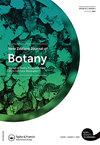澳洲、纽西兰及南非归化凤尾草复合体的遗传多样性
IF 1.4
4区 生物学
Q4 PLANT SCIENCES
引用次数: 0
摘要
枫香(Tradescantia fluuminensis)是澳大利亚、新西兰和南非的入侵物种。为了协助生物防治行动和物种管理,我们检查了这些国家的遗传变异,并将其与从巴西自然范围收集的样本进行比较。fluminensis在新西兰由两个遗传类群组成,这两个类群都与澳大利亚和南非共享。其中一种基因型在新西兰相对常见,巴西人群也有这种基因型。与新西兰相比,澳大利亚和南非的T. fluminensis种群的遗传变异更大。另外两个实体,T. mundula Kunth(同. T. albiflora hort.)和T. umbraculifera Hand-Mazz。(同t.a ff. fluminensis“大”),新西兰归化物种的新名称,也包括不同的遗传群体。这些遗传数据强调了对正在考虑进行生物防治计划的杂草物种进行正确分类鉴定的重要性。毛茛和柽柳的基因组大小和染色体数目相近(2n = 66、68、70和2C = 14.9),而柽柳的基因组大小和染色体数目较低(2n = 56、58;2C = 11.7皮图)。柽柳自花授粉和柽柳自花授粉均不能产生种子,证实了这两个类群是自交不亲和的。由于大多数(93%)的自花授粉产生的果实是自交亲和的。受蒙氏滴虫(T. mundula)授粉时,每果产生的果实和种子数量较少,而受氟米嫩滴虫(T. fluminensis)授粉时,每果不形成果实和种子。与野苔或小叶苔授粉的氟密草不能产生果实或种子。自交不亲和和与其他物种异花授粉时的结籽失败表明,入侵的氟米南在本地生态系统中不构成幼苗建立的威胁,植被传播仍然是其繁殖和入侵的主要方式。本文章由计算机程序翻译,如有差异,请以英文原文为准。
Genetic diversity of Tradescantia fluminensis complex (Commelinaceae) naturalised in Australia, New Zealand and South Africa
ABSTRACT
Tradescantia fluminensis Vell. is an invasive species in Australia, New Zealand and South Africa. To assist biocontrol initiatives and management of the species we examine genetic variation in these countries and compare this to samples collected from its natural range in Brazil. Tradescantia fluminensis comprises two genetic groupings in New Zealand, both of which are shared with Australia and South Africa. One of these genotypes is relatively common in New Zealand and this is also shared with a Brazilian population. Populations of T. fluminensis in Australia and South Africa are genetically more variable than in New Zealand. Two other entities, T. mundula Kunth (syn. T. albiflora hort.) and T. umbraculifera Hand-Mazz. (syn. T. aff. fluminensis “Big”), new names for naturalised species in New Zealand, also comprise distinct genetic groups. These genetic data emphasise the importance of correct taxonomic identification of weed species being considered for biological control programmes. Tradescantia mundula and T. umbraculifera share a similar genome size and chromosome numbers (2n = 66, 68, 70 and 2C = 14.9 picograms), whereas T. fluminensis had lower values (2n = 56, 58; 2C = 11.7 picograms). Self-pollinations of T. fluminensis and T. umbraculifera failed to produce seed, confirming that these two taxa are self-incompatible. Tradescantia mundula is self-compatible as the majority (93%) of self-pollinations produced fruit. Tradescantia umbraculifera produced a low number of fruit and seeds per fruit when pollinated by T. mundula, but no fruit or seeds were formed when it was pollinated by T. fluminensis. Tradescantia fluminensis pollinated with T. mundula or T. umbraculifera failed to produce fruit or seeds. Self-incompatibility and failure to set seed when cross-pollinated with other species suggests the invasive T. fluminensis does not pose a threat of seedling establishment in indigenous ecosystems and vegetative spread remains the main method of reproduction and invasion.
求助全文
通过发布文献求助,成功后即可免费获取论文全文。
去求助
来源期刊

New Zealand Journal of Botany
生物-植物科学
CiteScore
2.20
自引率
22.20%
发文量
27
审稿时长
>12 weeks
期刊介绍:
The New Zealand Journal of Botany publishes original research papers, review papers, perspectives, short communications, forum articles, letter and book reviews. We welcome submissions relevant to all aspects of the botany, mycology, and phycology of the South Pacific, Australia, South America, and Southern Africa. The journal’s subject matter encompasses biosystematics and biogeography, ecology, physiology, biochemistry, genetics, reproductive biology, structure and development, taxonomy, ethnobotany, palaeobotany, bryology, lichenology, mycology, plant pathology, and phycology.
 求助内容:
求助内容: 应助结果提醒方式:
应助结果提醒方式:


